Related Research Articles

Glamorgan, or sometimes Glamorganshire, is one of the thirteen historic counties of Wales and a former administrative county of Wales. Originally an early medieval petty kingdom of varying boundaries known in Welsh as the Kingdom of Morgannwg, which was then invaded and taken over by the Normans as the Lordship of Glamorgan. The area that became known as Glamorgan was both a rural, pastoral area, and a conflict point between the Norman lords and the Welsh princes. It was defined by a large concentration of castles.
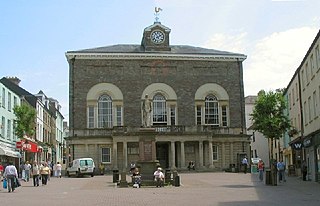
Carmarthenshire is a county in the south-west of Wales. The three largest towns are Llanelli, Carmarthen and Ammanford. Carmarthen is the county town and administrative centre. The county is known as the "Garden of Wales" and is also home to the National Botanic Garden of Wales.
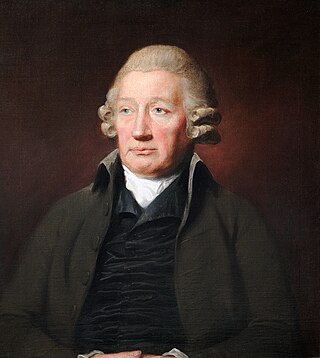
John "Iron-Mad" Wilkinson was an English industrialist who pioneered the manufacture of cast iron and the use of cast-iron goods during the Industrial Revolution. He was the inventor of a precision boring machine that could bore cast iron cylinders, such as cannon barrels and piston cylinders used in the steam engines of James Watt. His boring machine has been called the first machine tool. He also developed a blowing device for blast furnaces that allowed higher temperatures, increasing their efficiency, and helped sponsor the first iron bridge in Coalbrookdale. He is notable for his method of cannon boring, his techniques at casting iron and his work with the government of France to establish a cannon foundry.

Burry Port is a port town and community in Carmarthenshire, Wales, on the Loughor estuary, to the west of Llanelli and south-east of Kidwelly. Its population was recorded at 5,680 in the 2001 census and 6,156 in the 2011 census, and estimated at 5,998 in 2019. The town has a harbour. It is also where Amelia Earhart landed as the first woman to fly across the Atlantic Ocean. Nearby are the Pembrey Burrows sand dune and wetland system, forming a country park, and the Cefn Sidan sands. Its musical heritage includes Burry Port Opera, Male Choir and Burry Port Town Band.

Llandovery is a market town and community in Carmarthenshire, Wales. It lies on the River Tywi and at the junction of the A40 and A483 roads, about 25 miles (40 km) north-east of Carmarthen, 27 miles (43 km) north of Swansea and 21 miles (34 km) west of Brecon.

South Wales is a loosely defined region of Wales bordered by England to the east and mid Wales to the north. Generally considered to include the historic counties of Glamorgan and Monmouthshire, south Wales extends westwards to include Carmarthenshire and Pembrokeshire. In the western extent, from Swansea westwards, local people would probably recognise that they lived in both south Wales and west Wales. The Brecon Beacons National Park covers about a third of south Wales, containing Pen y Fan, the highest British mountain south of Cadair Idris in Snowdonia.
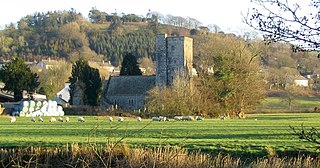
Llanybydder is a market town and community straddling the River Teifi in Carmarthenshire, West Wales. At the 2011 Census, the population of the community was 1638, an increase from 1423 at the 2001 Census.
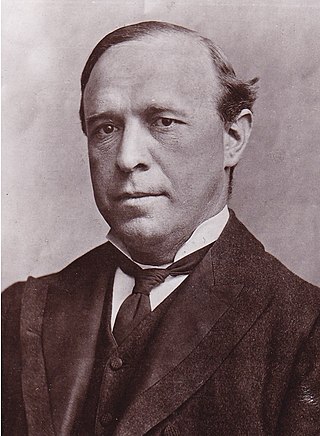
William Llewelyn Williams known as Llewelyn Williams, was a Welsh journalist, lawyer and radical Liberal Party politician.
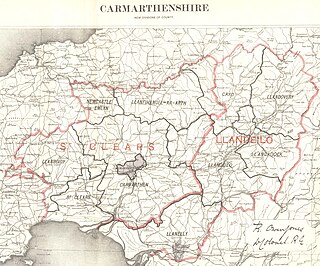
East Carmarthenshire was a county constituency in Carmarthenshire, Wales. It returned one Member of Parliament (MP) to the House of Commons of the Parliament of the United Kingdom, elected by the first past the post voting system.

Pont-ar-gothi is a village in Carmarthenshire, West Wales. The village takes its name from the bridge where the A40 Road trunk road crosses the River Cothi. It lies some 10 miles (16 km) east of Carmarthen.
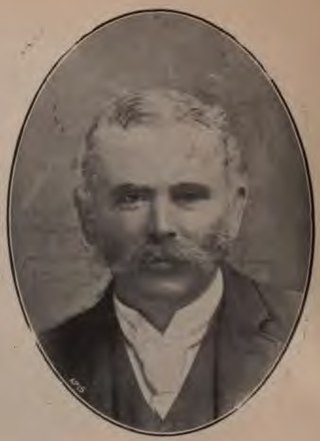
Abel Thomas was a Welsh Liberal politician and lawyer.
Ffairfach is a village one-half mile (0.80 km) south of the market town of Llandeilo in the eastern part of Carmarthenshire, Wales. It is located close to the confluence of the Afon Cennen and the River Towy. Population is 516 according to 2017 census.
Vivian & Sons was a British metallurgical and chemicals business based at Hafod, in the lower Swansea valley. The firm was founded in 1810, disappearing as a separate entity in 1924. Its chief outputs were ingot and sheet copper, with sulphuric acid and artificial manures as by-products.
The Llandovery Bank was established in 1799 in Llandovery, Wales, in the premises known as the King’s Head on Stone Street, where it remained for many years. The bank was locally known as the ‘Black Ox Bank’ because of the bank notes having been embellished with an engraving on the left hand side of a Welsh black ox.
Llanelly Bank was a 19th-century bank based in the Welsh town of Llanelli.
David Morris & Sons was a bank which was established in Carmarthenshire, Wales in the 18th century. It now a constituent part of The Royal Bank of Scotland Group.
Carmarthen Bank was a bank established and formerly operated in the county of Carmarthenshire, Wales during the 19th century. It became bankrupt in 1832 and its name was then adopted by another Carmarthenshire-based bank.

John Lloyd Morgan was Liberal Party Member of Parliament (MP) for West Carmarthenshire from 1889 to 1910.

The Melingriffith Tin Plate Works were post medieval tin and iron works located on Tŷ-mawr Road, in Whitchurch, Cardiff, Wales. Founded sometime before 1750, it was the largest tin-plate works in the world by the end of the 18th century. Subsequent to the closure of tin plate works in 1957, the 200-year-old Melingriffith water pump was named a scheduled monument. It is one of the earliest and most important works of its kind, and may be "the most notable surviving monument of the tinplate industry".

The industrial revolution in Wales refers to the notable developments in technology and the resultant increases in the scale of industry in Wales which took place in the 18th and 19th centuries as part of the wider Industrial Revolution.
References
- 1 2 3 4 5 6 7 8 Early Banks in West Wales, by Francis Green ( in West Wales Historical Records, The Annual Magazine of The Historical Society of West Wales, Volume VI, edited by Francis Green, Printed by W. Spurrell & Son, 1916)
- 1 2 Lloyd., T., Orbach., J., Scourfield, R., 2006, Pevsner Architectural Guides, The Buildings of Wales, Carmarthenshire and Ceredigion, Yale University Press ISBN 0-300-10179-1